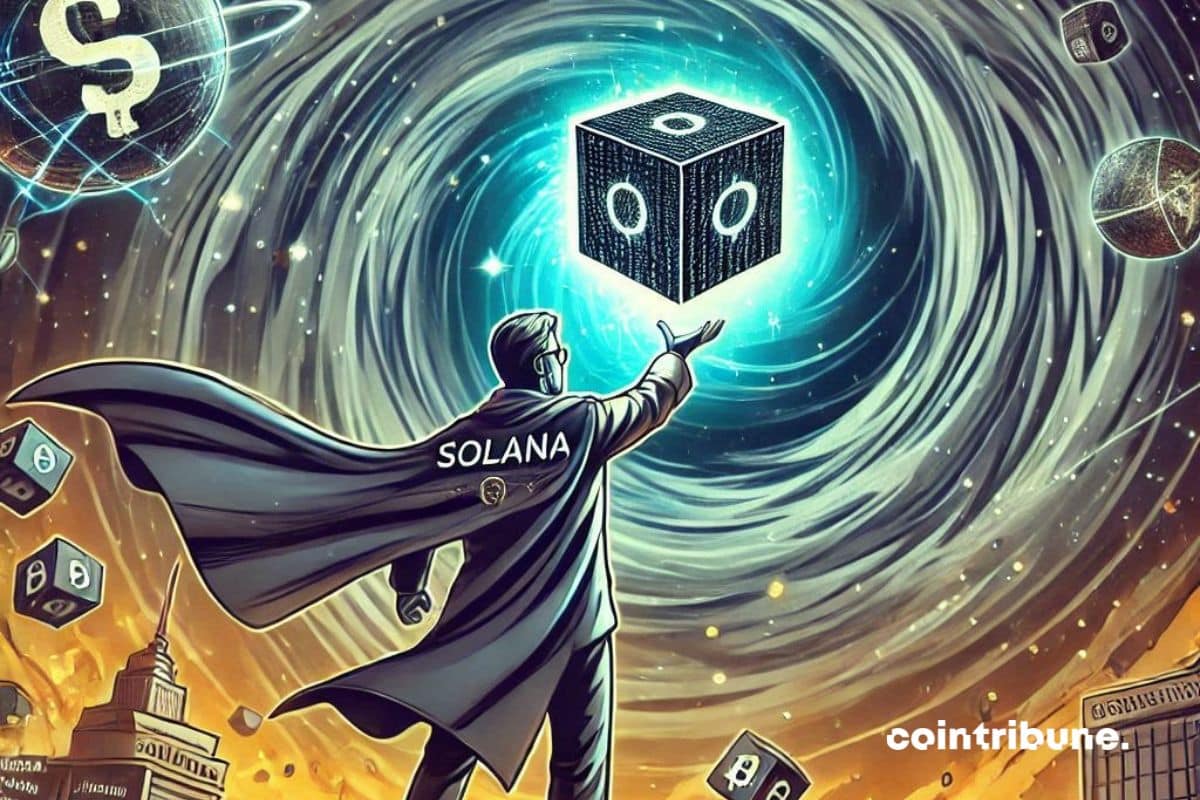At the beginning of 2025, Cardano (ADA) is attracting the attention of investors due to a bullish sentiment and increased network activity. Discover how these factors could propel the price of ADA to new highs and what this means for crypto traders and investors.
Theme Blockchain
Solana, the audacious blockchain, humiliated Ethereum in broad daylight: 3.8 billion in 24 hours, leaving its rivals stunned. A memorable slap in the crypto arena.
For the first time in 2025, bitcoin has crossed the $102,000 mark today, marking a significant turning point for the world's best-known cryptocurrency. This spectacular rise is attributed to 4 key factors that have converged to propel the price of bitcoin to new heights.
Bitcoin reaches $99,562, breaks a key resistance level, and is charging straight towards $100,000! However, what surprise awaits BTC? A rise to $120,000 or an imminent correction to $92,000? Let's explore technical trends and perspectives together.
Solana, a blockchain known for its speed and efficiency, has recently achieved a major milestone by becoming resistant to quantum attacks. This advancement was announced by a Solana developer, who explained that the solution is based on an ancient yet extremely robust crypto technique.
How to know how much you can earn from BTC mining? Discover the answer in this comprehensive guide to bitcoin mining. Before knowing how much bitcoin mining can yield, one must first understand how this activity works.
Mining involves using powerful computers to solve complex problems and validate transactions on the blockchain. Among the equipment used to mine Bitcoin, ASICs are certainly the most widespread in the industry. Discover everything you need to know to get started with ASIC mining!
Are you interested in mining Bitcoin (BTC) and hesitating to start with a processor (CPU)? Know that it is entirely possible to mine Bitcoin using the processing power of your computer. In fact, it is an easy way to get started in cryptocurrency mining, as you do not need expensive hardware or special knowledge. In this article, we will guide you through your first steps in CPU mining.
Have you ever heard of FPGA? It is a type of hardware used for mining cryptocurrency, whose popularity continues to grow. This article covers all the necessary steps to mine Bitcoin (BTC) with this device. But before diving into the heart of the matter, let’s start by defining the concept and what the advantages and disadvantages of this practice are.
The Stratum mining protocol is an essential component of the Bitcoin (BTC) network. It allows mining software to connect efficiently and securely to the blockchain, optimizing the mining process. Developed in 2012, Stratum has since become the most popular protocol used for mining bitcoins. In this post, we will explore the definition of this technology and the reasons why it is so important for Satoshi Nakamoto's network.
Bitcoin is a popular cryptocurrency that facilitates secure and decentralized exchanges. Each transfer of bitcoins from one user to another is a mathematically verified operation to ensure the reliability of exchanges. Let's see how these calculations take place in the network and how they contribute to the bitcoin mining process.
Bitcoin mining is the process by which new units of bitcoins (BTC) are created. It is an effective method if you want to acquire Bitcoin. But before you dive into this activity, you may be wondering how long it takes to generate BTC. In this article, we will explore this question in depth. You will discover, among other things, how difficulty, hash rate, and other parameters influence this metric.
Bitcoin is a digital currency that has quickly gained popularity in recent years. One of the key components of Bitcoin is the hash value, which is a unique identifier associated with each transaction and each Bitcoin block. In this article, we will explore what a hash value is and why it is so important for the Bitcoin blockchain.
The hashprice is a very important metric for crypto miners. It is particularly useful when it comes to determining the profitability of their operations. Therefore, if you are interested in Bitcoin (BTC) mining, or if you are simply a cryptocurrency enthusiast, you will probably want to learn more about it. This article explains in detail what hash price is and why it is so relevant in the crypto industry.
Initially, Bitcoin (BTC) mining was an activity practiced exclusively by a handful of insiders. However, over time, more and more people began to engage in it. As the phenomenon grew, mining farms started to emerge. In this article, we will explore what these platforms are, how they operate, and why they are interesting. We will also look at how they are powered, whether they are profitable, and what their future holds.
MEXC, a leading global crypto trading platform, has recently concluded its December 2024 Supercar giveaway, a landmark event that gathered over 125,000 participants from around the world. With an impressive prize pool of 6,000,000 USDT, this event not only demonstrated MEXC's growing popularity but also its commitment to providing an exceptional user experience.
In 2024, Ethereum saw a significant increase in its long-term holders (HODLers), reflecting heightened investor confidence. This trend contrasts with the decline in Bitcoin holders, indicating promising prospects for Ethereum in 2025 and significant implications for the crypto market.
Ethereum (ETH) has recently experienced a significant decrease in selling pressure, signaling a possible market recovery. Here are the four main reasons identified that explain this trend, and what it could mean for the future of the Ethereum cryptocurrency.
Since the end of November 2024, the prices of Solana (SOL) have fallen by more than 30%, raising concerns among investors and crypto enthusiasts. This significant decline comes after a period of strong growth, where Solana had reached historical highs.
The price of Ripple (XRP) has seen a spectacular increase of over 300% in the last two months, reaching $2.10 on December 27, 2024. However, warning signs suggest that the XRP cryptocurrency could collapse by at least 25% in the coming days.
In 2024, the intersection of artificial intelligence (AI) and blockchain has become a major trend. AI-focused crypto projects are now concentrating on developing autonomous agents capable of performing tasks such as trading, investment management, and user interaction.
Rune transactions on the Bitcoin network have recently hit a new historical low, representing only 1.67% of daily transactions. This figure marks a significant decrease compared to the period between April and November when Rune transactions often accounted for over 50% of daily transactions on the Bitcoin network.
A famous economist recently announced the arrival of the "Santa Claus rally" for Bitcoin, predicting a spectacular price increase by the end of the year. This trend, supported by strong technical backing, could propel BTC to new historical highs, despite some challenges.
A crypto analyst, Michael van de Poppe, predicts that Ethereum (ETH) could surpass Bitcoin (BTC) in January 2025. This prediction is based on a key factor, which could trigger an "altcoin run" and attract more investments into the Ethereum ecosystem.
In December 2024, Bitcoin experienced a slight decline of 2.4%, raising questions about the end of the bull market. Despite this drop, BTC remains a winning asset for the year, with an increase of nearly 50% in the fourth quarter.
The "Santa Claus rally" seems to have hit a snag this year, with Bitcoin reaching its lowest price of December 2024 at $92,442. This unexpected drop has surprised investors, calling into question the historical trends of rising prices during the holiday season.
Nokia, the Finnish telecommunications giant, is heading towards a new digital era with a patent dedicated to the encryption of digital resources. This project could mark a significant advancement in securing crypto assets and blockchain technology.
The cryptocurrency market has recently gone through a correction period, with Bitcoin leading this decline. According to a recent report, the realized losses have exceeded the weekly average, signaling a possible end to this correction. With Bitcoin currently rising to $98,600, can we already turn the page on this bearish period?
The sharp-toothed memecoin bites into blockchain innovation with Chainlink, flirting with 12 chains in a disconcertingly elegant technological dance.
The world of cryptocurrencies is in turmoil as mentions of "Buy the Dip" on social media reach their highest level in eight months. According to recent data, this trend was observed after the price of BTC fell below the psychological threshold of $100,000 on December 19, 2024. However, is a new ATH of $118,000 before 2025 feasible?





























